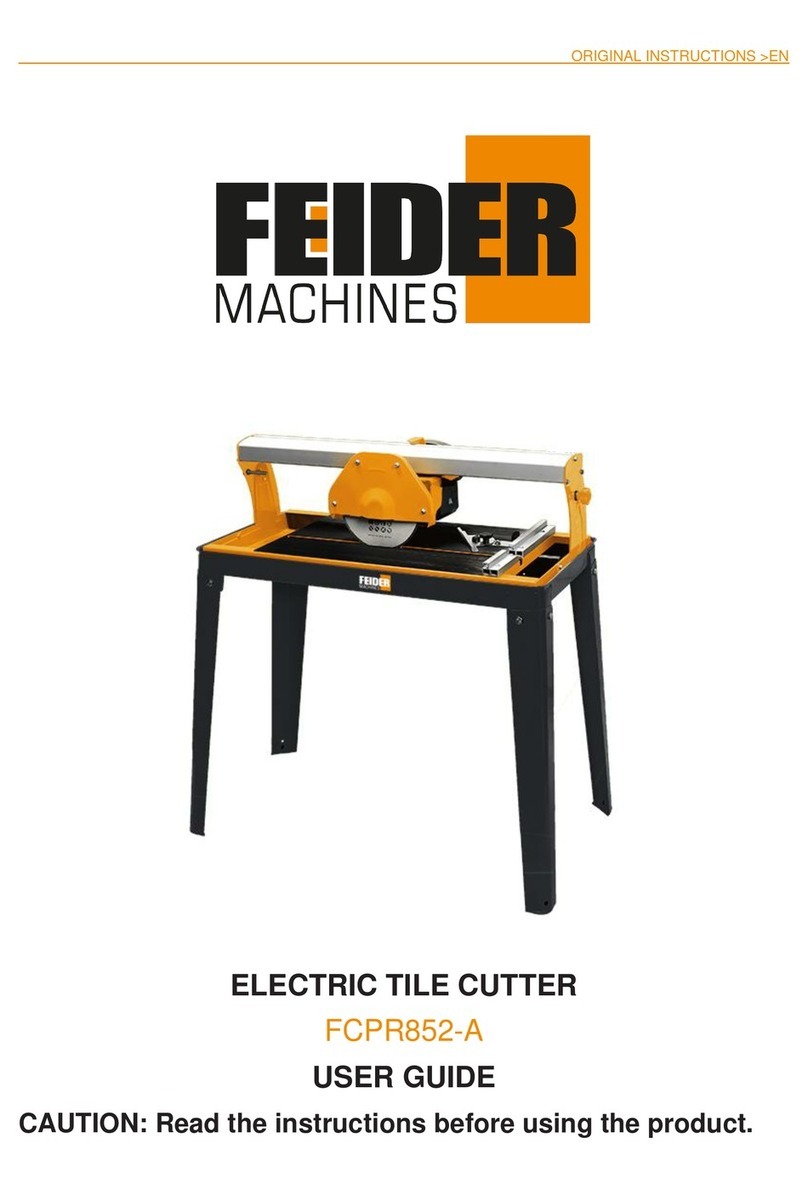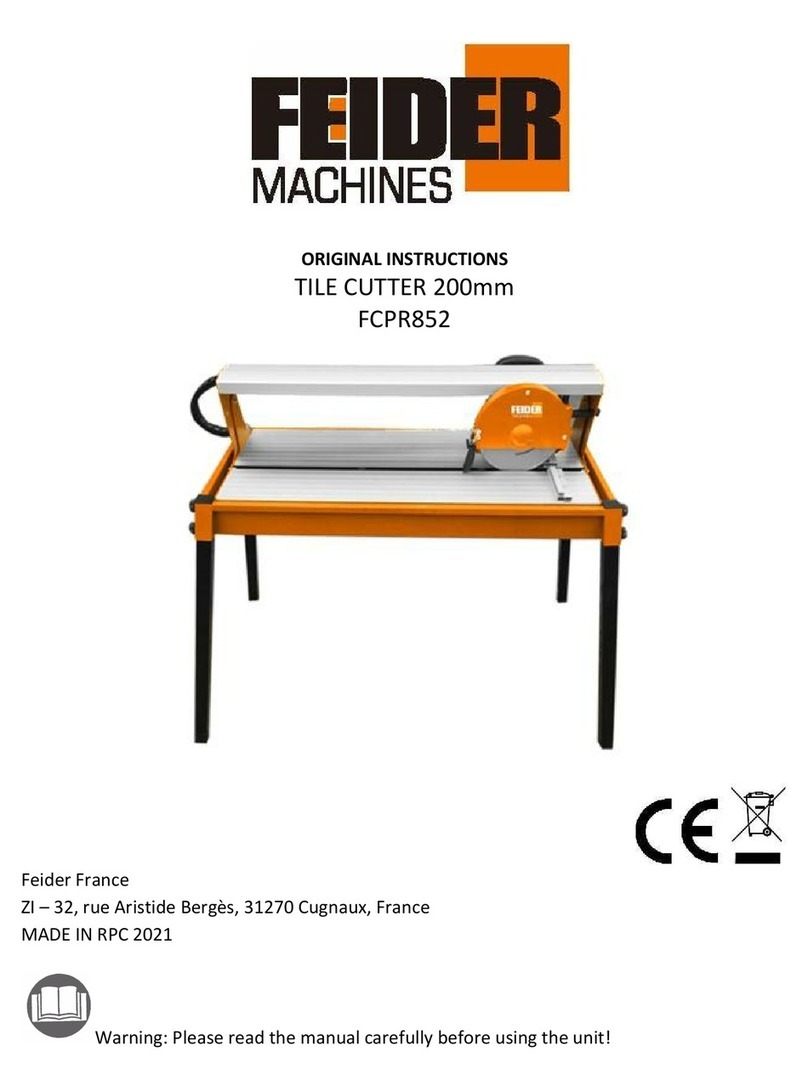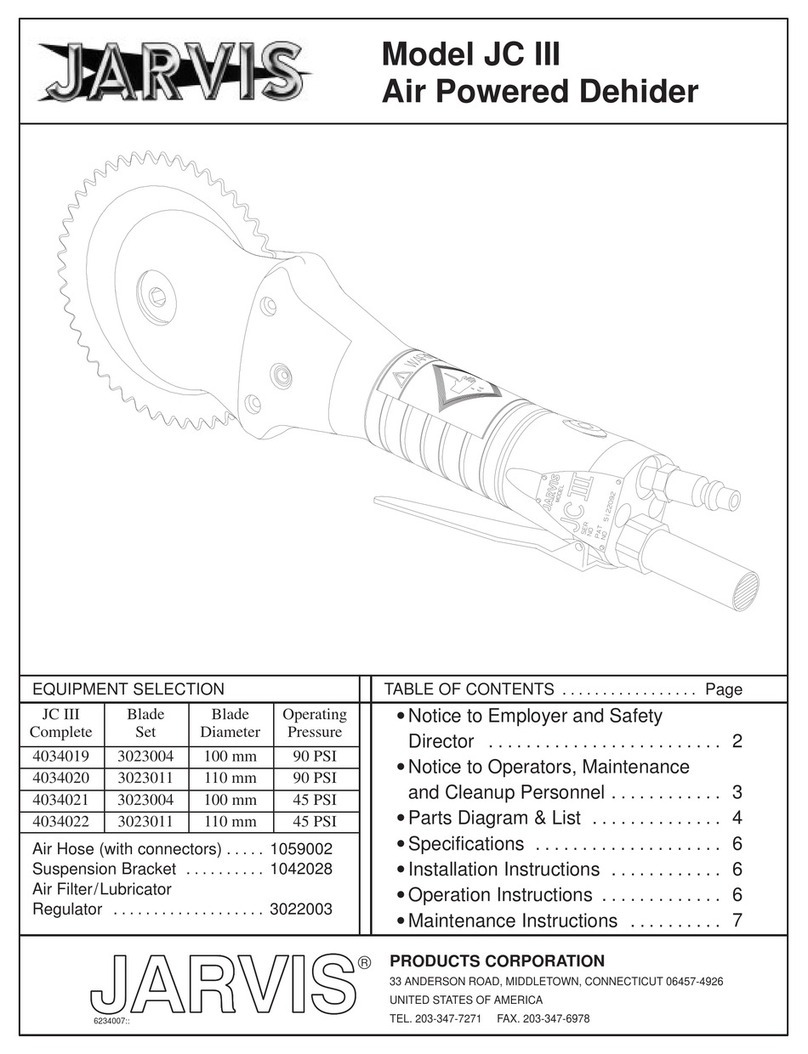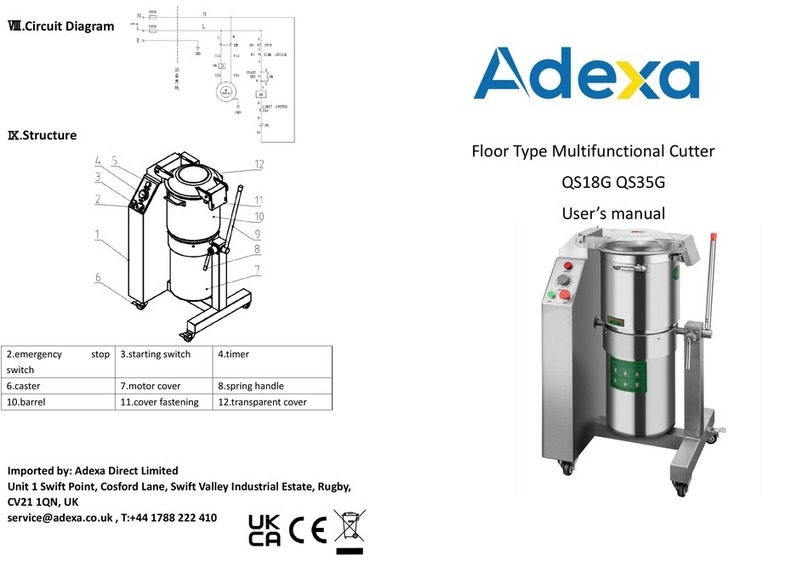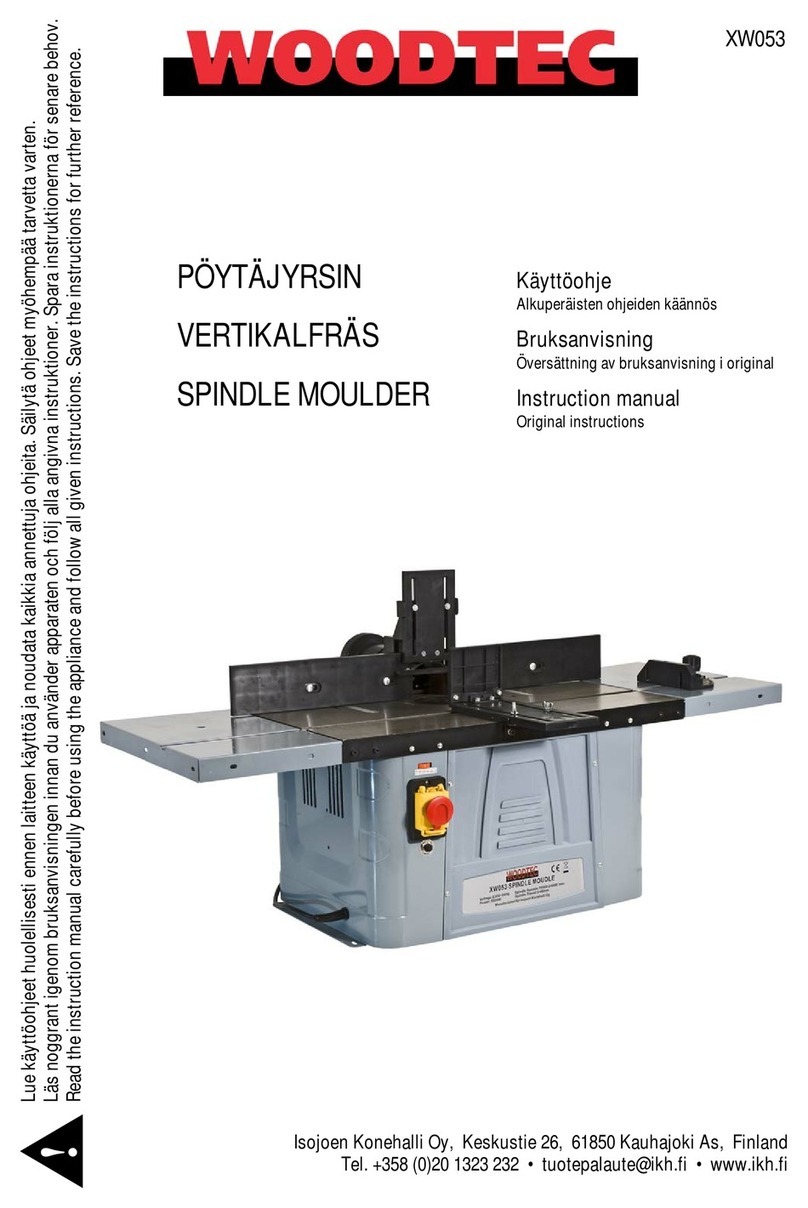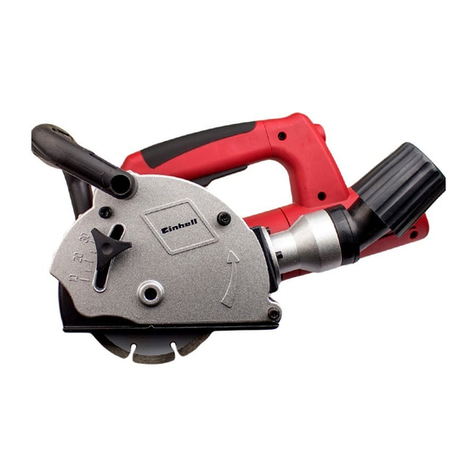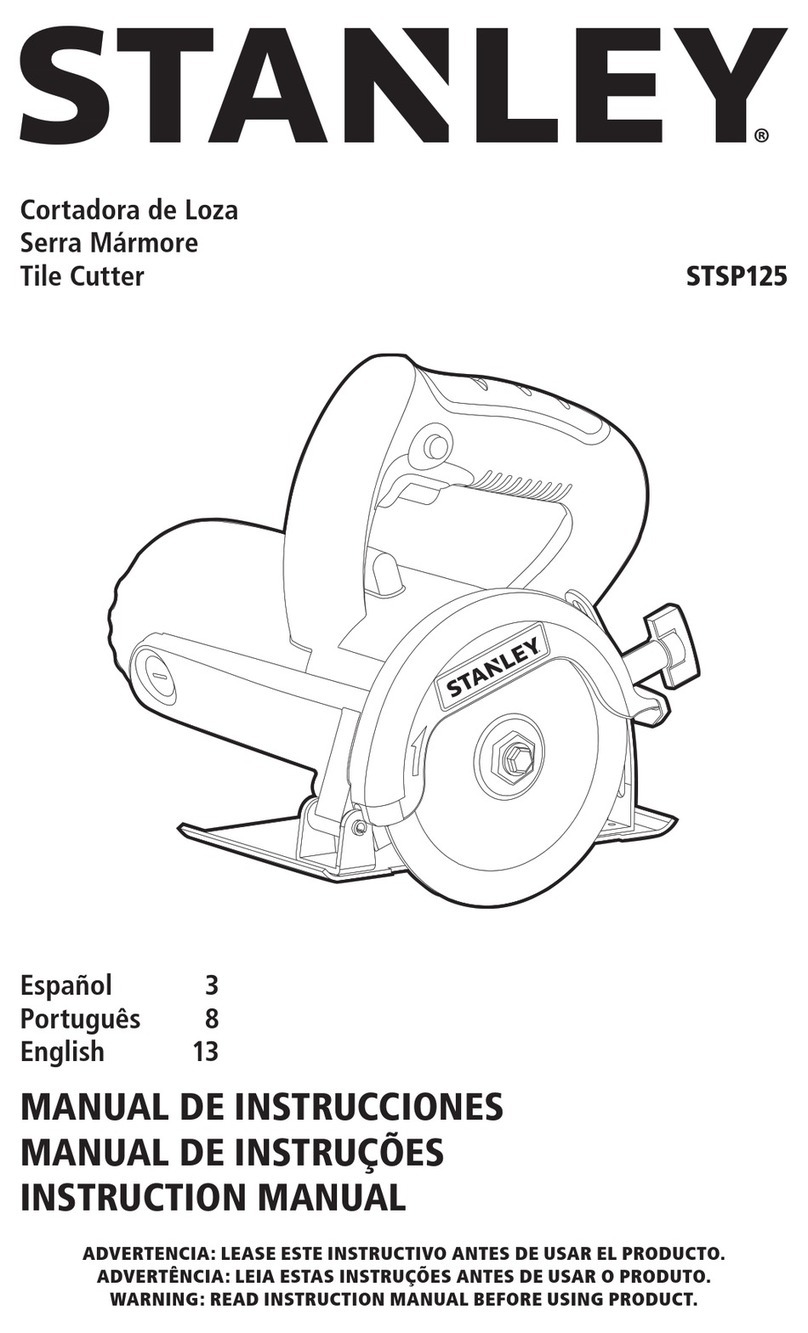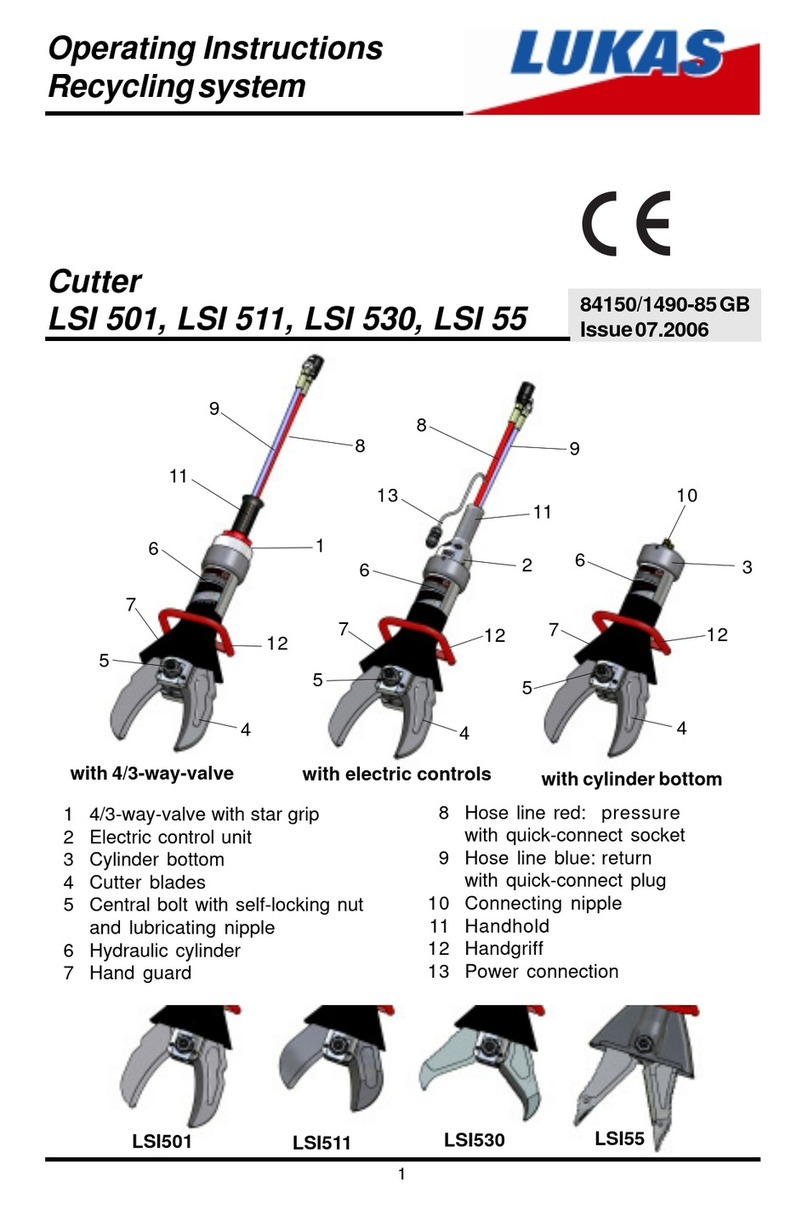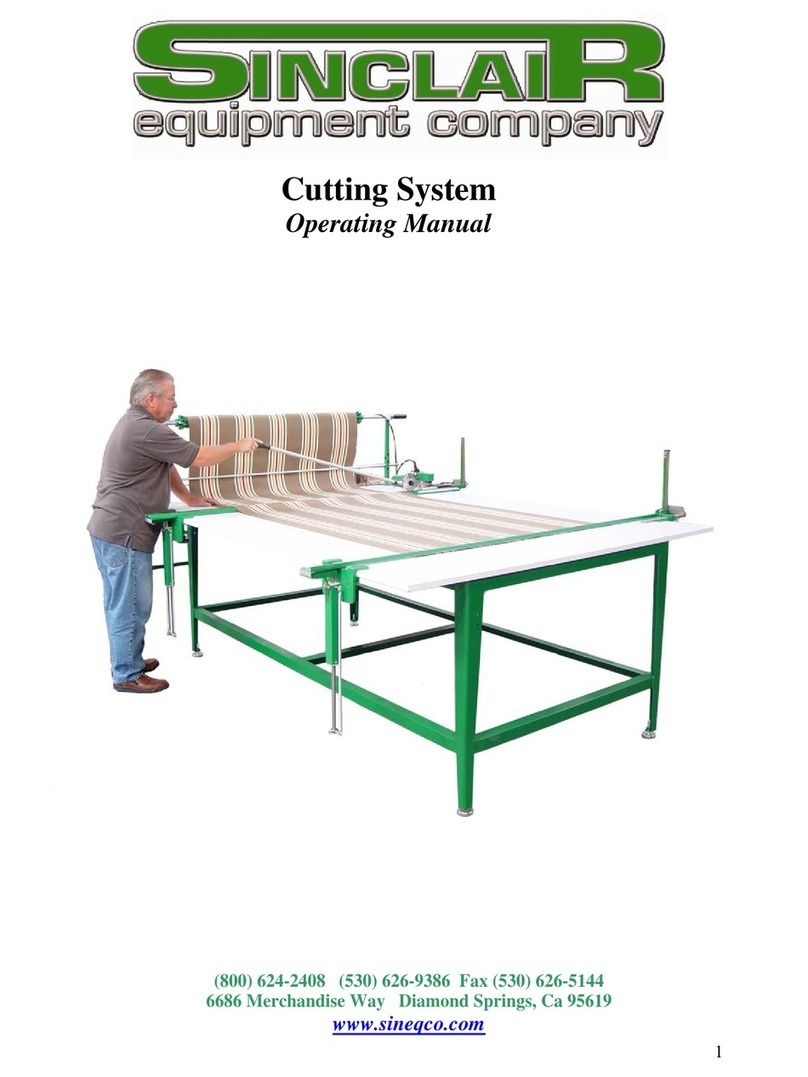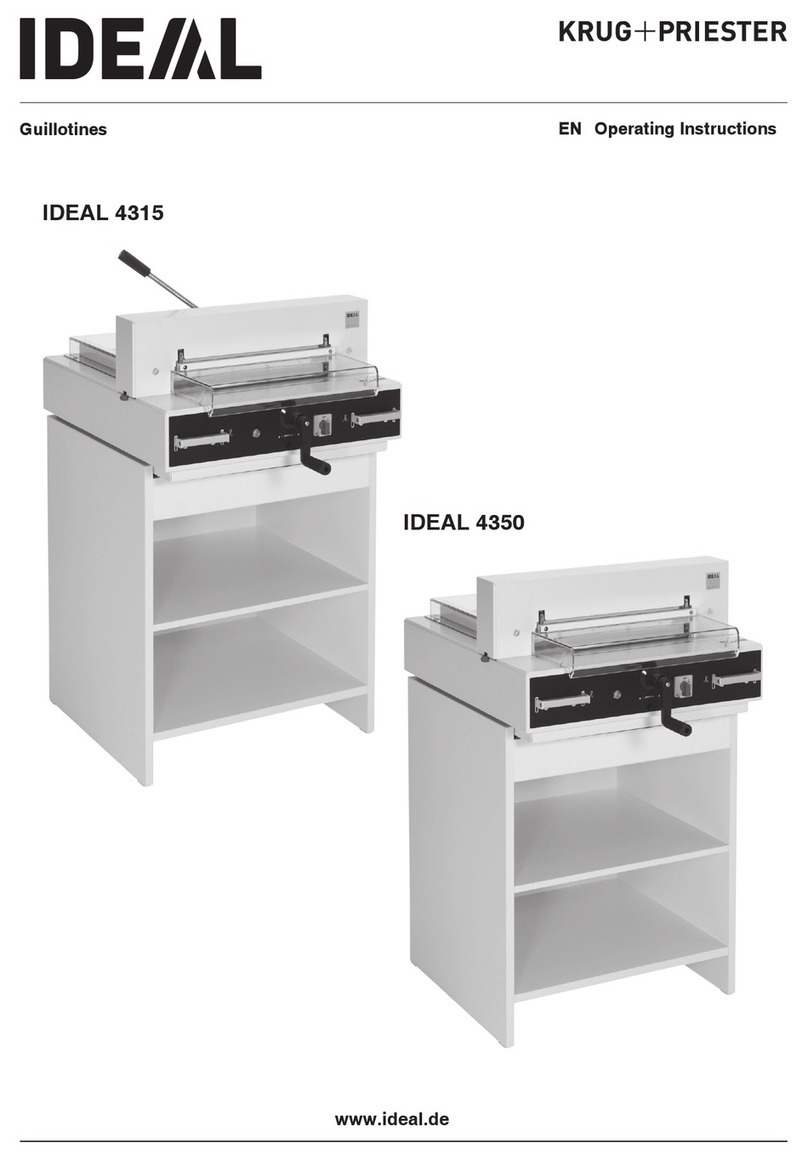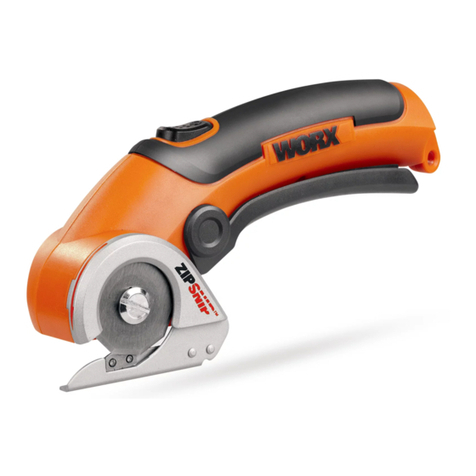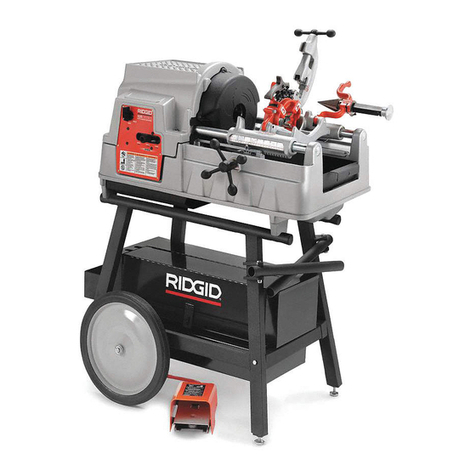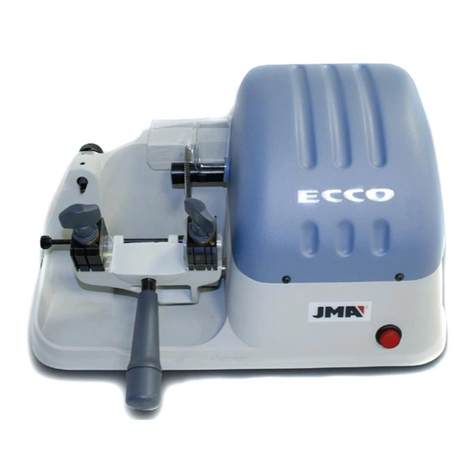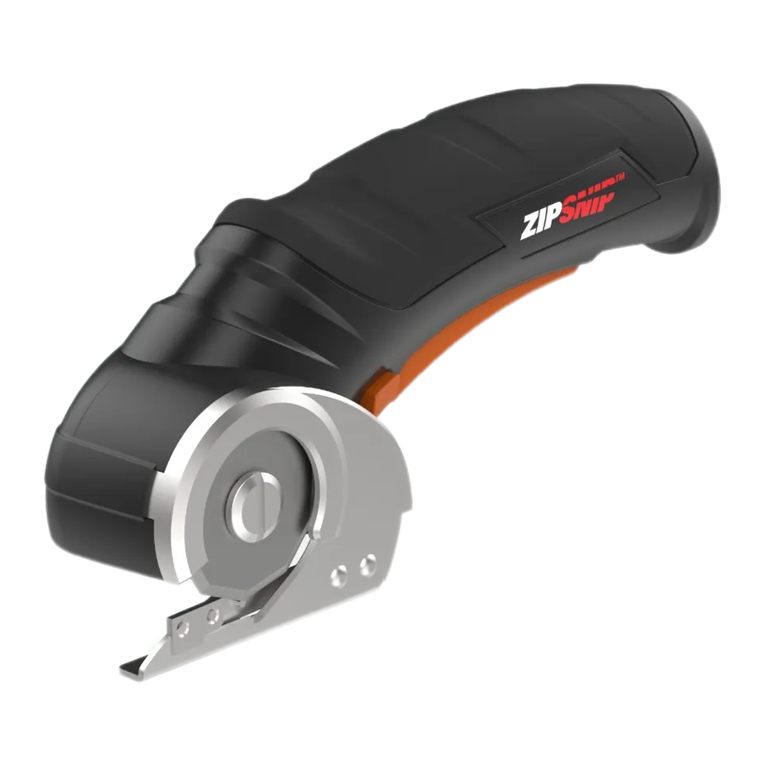Feider Machines F2000TM-A User manual

ORIGINAL INSTRUCTIONS >EN
CUTTING MACHINE
F2000TM-A
USER GUIDE
CAUTION: Read the instructions before using the product.

CONTENTS
1. SAFETY INSTRUCTIONS………………………………………………………3
2. PRODUCT DESCRIPTION……………………………………………………..7
3. SPECIFICATIONS……………………………………………………………….8
4. OPERATION……………………………………………………………………...9
5. MAINTENANCE…………………………………………………………...……11
6. DISPOSAL…………………………………………………………………...….11
7. DECLARATION OF CONFORMITY………………………………………….12
8. WARRANTY…………………………………………………………………….13
9. PRODUCT FAILURE…………………………………………………………..14
10. WARRANTY EXCLUSIONS…………………………………………………15

1. SAFETY INSTRUCTIONS
1.1 GENERAL POWER TOOL SAFETY WARNINGS
WARNING: Read all safety warnings, instructions, illustrations and specifications provided
with this power tool. Failure to follow all instructions listed below may result in electric shock, fire and/or
seriousinjury.
Save all warnings and instructions for future reference.
The term "power tool" in the warnings refers to your mains-operated (corded) power tool or
battery-operated(cordless) power tool.
1)Work area safety
a) Keep work area clean and well lit. Cluttered or dark areas invite accidents.
b) Do not operate power tools in explosive atmospheres, such as in the presence of flammable
liquids, gases or dust. Power tools create sparks which may ignite the dust or fumes.
c) Keep children and bystanders away while operating a power tool. Distractions can cause you to
losecontrol.
2)Electrical safety
a) Power tool plugs must match the outlet. Never modify the plug in any way. Do not use any
adapter plugs with earthed (grounded) power tools. Unmodified plugs and matching outlets will
reduce risk of electric shock.
b) Avoid body contact with earthed or grounded surfaces, such as pipes, radiators, ranges and
refrigerators. There is an increased risk of electric shock if your body is earthed or grounded.
c) Do not expose power tools to rain or wet conditions. Water entering a power tool will increase the
riskof electric shock.
d) Do not abuse the cord. Never use the cord for carrying, pulling or unplugging the power tool.
Keepcord away from heat, oil, sharp edges or moving parts. Damaged or entangled cords increase
the risk ofelectric shock.
e) When operating a power tool outdoors, use an extension cord suitable for outdoor use. Use of
a cord suitable for outdoor use reduces the risk of electric shock.
f) If operating a power tool in a damp location is unavoidable, use a residual current device (RCD)
protected supply. Use of an RCD reduces the risk of electric shock.
3)Personal safety
a) Stay alert, watch what you are doing and use common sense when operating a power tool. Do
notuse a power tool while you are tired or under the influence of drugs, alcohol or medication. A
momentof inattention while operating power tools may result in serious personal injury.
b) Use personal protective equipment. Always wear eye protection. Protective equipment such as a
dust mask, non-skid safety shoes, hard hat or hearing protection used for appropriate conditions will
reducepersonal injuries.
c) Prevent unintentional starting. Ensure the switch is in the off-position before connecting to
powersource and/or battery pack, picking up or carrying the tool. Carrying power tools with your
finger on theswitch or energising power tools that have the switch on invites accidents.
d) Remove any adjusting key or wrench before turning the power tool on. A wrench or a key left
attached to a rotating part of the power tool may result in personal injury.
e) Do not overreach. Keep proper footing and balance at all times. This enables better control of
thepower tool in unexpected situations.
f) Dress properly. Do not wear loose clothing or jewellery. Keep your hair and clothing away
frommoving parts. Loose clothes, jewellery or long hair can be caught in moving parts.
g) If devices are provided for the connection of dust extraction and collection facilities, ensure
3

theseare connected and properly used. Use of dust collection can reduce dust-related hazards.
h) Do not let familiarity gained from frequent use of tools allow you to become complacent and
ignore tool safety principles. A careless action can cause severe injury within a fraction of a second.
4)Power tool use and care
a) Do not force the power tool. Use the correct power tool for your application. The correct power
toolwill do the job better and safer at the rate for which it was designed.
b) Do not use the power tool if the switch does not turn it on and off. Any power tool that cannot be
controlled with the switch is dangerous and must be repaired.
c) Disconnect the plug from the power source and/or remove the battery pack, if detachable, from
the power tool before making any adjustments, changing accessories, or storing power tools.
Such preventive safety measures reduce the risk of starting the power tool accidentally.
d) Store idle power tools out of the reach of children and do not allow persons unfamiliar with the
power tool or these instructions to operate the power tool. Power tools are dangerous in the hands
of untrained users.
e) Maintain power tools and accessories. Check for misalignment or binding of moving parts,
breakage of parts and any other condition that may affect the power tool’s operation. If damaged,
have the power tool repaired before use. Many accidents are caused by poorly maintained power
tools.
f) Keep cutting tools sharp and clean. Properly maintained cutting tools with sharp cutting edges are
lesslikely to bind and are easier to control.
g) Use the power tool, accessories and tool bits etc. in accordance with these instructions, taking
into account the working conditions and the work to be performed. Use of the power tool for
operationsdifferent from those intended could result in a hazardous situation.
h) Keep handles and grasping surfaces dry, clean and free from oil and grease. Slippery handles
and grasping surfaces do not allow for safe handling and control of the tool in unexpected situations.
5)Service
a) Have your power tool serviced by a qualified repair person using only identical replacement parts.
This will ensure that the safety of the power tool is maintained.
1.2 SAFETY INSTRUCTIONS FOR CUT OFF MACHINES
1) Cut-off machine safety warnings
a) Position yourself and bystanders away from the plane of the rotating wheel. The guard helps to
protect the operator from broken wheel fragments and accidental contact with wheel.
b) Use only bonded reinforced or diamond cut-off wheels for your power tool. Just because an
accessory can be attached to your power tool, it does not assure safe operation.
c) The rated speed of the accessory must be at least equal to the maximum speed marked on the
power tool. Accessories running faster than their rated speed can break and fly apart.
d) Wheels must be used only for recommended applications. For example: do not grind with the
side of a cut-off wheel. Abrasive cut-off wheels are intended for peripheral grinding, side forces applied
to these wheels may cause them to shatter.
e) Always use undamaged wheel flanges that are of correct diameter for your selected wheel.
Proper wheel flanges support the wheel thus reducing the possibility of wheel breakage.
f) The outside diameter and the thickness of your accessory must be within the capacity rating of
your power tool. Incorrectly sized accessories cannot be adequately guarded or controlled.
g) The arbour size of wheels and flanges must properly fit the spindle of the power tool. Wheels
and flanges with arbour holes that do not match the mounting hardware of the power tool will run out of
balance, vibrate excessively and may cause loss of control.
4

h) Do not use damaged wheels. Before each use, inspect the wheels for chips and cracks. If the
power tool or wheel is dropped, inspect for damage or install an undamaged wheel. After
inspecting and installing the wheel, position yourself and bystanders away from the plane of the
rotating wheel and run the power tool at maximum no load speed for one minute. Damaged
wheels will normally break apart during this test time.
i) Wear personal protective equipment. Depending on application, use face shield, safety goggles
or safety glasses. As appropriate, wear dust mask, hearing protectors, gloves and shop apron
capable of stopping small abrasive or workpiece fragments. The eye protection must be capable of
stopping flying debris generated by various operations. The dust mask or respirator must be capable of
filtrating particles generated by your operation. Prolonged exposure to high intensity noise may cause
hearing loss.
j) Keep bystanders a safe distance away from work area. Anyone entering the work area must
wear personal protective equipment. Fragments of workpiece or of a broken wheel may fly away and
cause injury beyond immediate area of operation.
k) Position the cord clear of the spinning accessory. If you lose control, the cord may be cut or
snagged and your hand or arm may be pulled into the spinning wheel.
l) Regularly clean the power tool’s air vents. The motor’s fan can draw the dust inside the housing
and excessive accumulation of powdered metal may cause electrical hazards.
m) Do not operate the power tool near flammable materials. Do not operate the power tool while
placed on a combustible surface such as wood. Sparks could ignite these materials.
n) Do not use accessories that require liquid coolants. Using water or other liquid coolants may
result in electrocution or shock.
2) Kickback and related warnings
Kickback is a sudden reaction to a pinched or snagged rotating wheel. Pinching or snagging causes
rapid stalling of the rotating wheel which in turn causes the uncontrolled cutting unit to be forced upwards
toward the operator.
For example, if an abrasive wheel is snagged or pinched by the workpiece, the edge of the wheel that is
entering into the pinch point can dig into the surface of the material causing the wheel to climb out or kick
out. Abrasive wheels may also break under these conditions.
Kickback is the result of power tool misuse and/or incorrect operating procedures or conditions and can
be avoided by taking proper precautions as given below.
a) Maintain a firm grip on the power tool and position your body and arm to allow you to resist
kickback forces. The operator can control upward kickback forces, if proper precautions are taken.
b) Do not position your body in line with the rotating wheel. If kickback occurs, it will propel the
cutting unit upwards toward the operator.
c) Do not attach a saw chain, woodcarving blade, segmented diamond wheel with a peripheral
gap greater than 10 mm or toothed saw blade. Such blades create frequent kickback and loss of
control.
d) Do not “jam” the wheel or apply excessive pressure. Do not attempt to make an excessive
depth of cut. Overstressing the wheel increases the loading and susceptibility to twisting or binding of
the wheel in the cut and the possibility of kickback or wheel breakage.
e) When the wheel is binding or when interrupting a cut for any reason, switch off the power tool
and hold the cutting unit motionless until the wheel comes to a complete stop. Never attempt to
remove the wheel from the cut while the wheel is in motion otherwise kickback may occur.
Investigate and take corrective action to eliminate the cause of wheel binding.
f) Do not restart the cutting operation in the workpiece. Let the wheel reach full speed and
carefully re-enter the cut. The wheel may bind, walk up or kickback if the power tool is restarted in the
workpiece.
5

g) Support any oversized workpiece to minimize the risk of wheel pinching and kickback. Large
workpieces tend to sag under their own weight. Supports must be placed under the workpiece near the
line of cut and near the edge of the workpiece on both sides of the wheel.
1.3 SPECIFIC SAFETY INSTRUCTIONS
a) Make sure the cut-off wheel is securely mounted as described in the assembly instructions before
connecting the tool to a power supply. Do not tighten wheel excessively, since this can cause cracks.
b) Check wheel for fissures and cracks, and test for normal operation prior to use.
c) Use only cut-off wheels rated for 4400 rpm or greater and manufactured in compliance with ANSI B7.1.
Always store the wheels in a dry place with little temperature variation.
d) Always ease the abrasive wheel against the work piece when starting to cut. A harsh impact can break
the wheel.
e) Always press the trigger switch and allow the cut-off wheel to reach full speed before cutting.
f) Ensure that the cut-off machine is always used on a stable and level surface and instruction how to
secure the machine if used on a workbench.
g) Wear hearing protection, and protective gloves when handling wheels.
h) The wheel is a bonded reinforced wheel. This wheel can be used for different applications.
i) Use blotters, when they are provided with a bonded reinforced product.
j) This machine is designed to cut different shapes of metals, steel bars, using the grinding wheel provided.
Do not use it to cut wood or plastic.
Symbols explanation
To reduce the risk of injury, the user must read and understand this
manual before using this product.
Wear protective goggles
Wear ear protectors. Exposure to noise can cause hearing loss.
Wear respiratory protection.
In accordance with essential applicable safety standards of European
directives.
Double insulation.
Waste electrical products should not be disposed of with household
waste. Please recycle where facilities exist. Check with your local
authority or retailer for recycling advice.
6

2. PRODUCT DESCRIPTION
1.Carbon brush cap
2. Safety guard
3. Vise handle
4. Rubber foot
5. Base
6. Blade
7. Top guard
8. Switch
9. Handle
7

3. SPECIFICATIONS
Model
F2000TM-A
Mains voltage/ frequency
220-240V~, 50Hz
Power
2300W
Speed
3800/min
Blade size
Ø355mm
Weight
16.5kg
Sound pressure level LpA
92.2dB(A)
Sound power level LwA
105.2 dB(A)
Uncertainty K:
3 dB(A)
The total vibration value does not exceed 2,5 m/s²
Information:
•The declared noise emission value(s) have been measured in accordance with a standard test method
and may be used for comparing one tool with another;
•The declared noise emission value(s) may also be used in a preliminary assessment of exposure.
Warning:
•The noise emissions during actual use of the power tool can differ from the declared values depending
on the ways in which the tool is used especially what kind of workpiece is processed;
•Need to identify safety measures to protect the operator that are based on an estimation of exposure in
the actual conditions of use (taking account of all parts of the operating cycle such as the times when the
tool is switched off and when it is running idle in addition to the trigger time).
8

4. OPERATION
Warning.
Do not connect the saw to power source until assembly is complete. Failure to comply could result
in accidental starting and possible serious injury.
Warning.
4.1 CUT-OFF WHEEL REMOVAL
1) Be sure the tool is disconnected from the power source.
2) Raise the tool to its fully open position, remove nut on the blade cover and rotate the lower wheel guard
downward, exposing the hex head bolt which secures the abrasive wheel to the wheel arbor.
3) Push in the shaft lock lever and rotate the wheel until the safety lock level engages, locking the wheel in
place.
4) While holding the shaft lock lever in place, use a wrench and loosen the hex head bolt by rotating it
counterclockwise. Remove the hex bolt, washing, outside flange and abrasive wheel.
4.2 CUT-OFF WHEEL INSTALLATION
1) Be sure the tool is disconnected from the power source.
2) Inspect the replacement wheel for defects such as cracks, chipping, and correct speed rating. If defects
are found or the speed rating is not greater than 4400RPM discard the wheel and select another.
3) Remove any debris from the inside flange and inner washer. Position the new abrasive wheel over the
inner washer and against the inside flange.
4) Clean and align the outside flange to the wheel arbor, then slide it onto the arbor until it rests flush
against the abrasive wheel.
5) Insert the hex head bolt onto the threaded end of the wheel arbor and rotate it in a clockwise direction
until snug. Then depress the shaft lock lever to prevent the shaft from rotating, use the supplied wrench
to securely tighten the hex head bolt to hold the abrasive wheel firmly in place.
Warning. Do not over tighten the hex bolt. Over tightening can cause the new wheel to crack,
resulting in premature failure and possible serious injury.
6) Return the wheel guard to its lowest position and replace nut to secure wheel guard.
4.3 DOUBLE ACTION SAFETY SWITCH
To prevent unauthorized use of the cut off saw, only when pressing both the trigger and the padlock, the
machine can be operated.
4.4 ADJUSTABLE STATIONARY VICE
The adjustable stationary vise is located on the base of your cut-off saw. This vice can be rotated to attain
cutting angles from 0 to 45 degrees and moved rearward to allow greater cutting widths.
9
1.Don't use the cut-off machine without protective cover on suitable position.
2.The recommended thick of grinding wheel is 2.8mm, and diameter of wheel's hole is 25.4mm.
3. The maximum cutting capacity of cut-off machine is 130mm.

Warning. Always unplug the saw from power source before adjusting or performing routine
maintenance. Failure to heed this warning can result in serious injury.
4.5 CUTTING ANGLE ADJUSTMENT
1) Using the supplies wrench, loosen hex head bolts behind the vise fence;
2) Rotate the vise fence until the desired angle of the cut is aligned with the indicator groove in the saw
base.
3) Check the angle of the vise fence to the abrasive wheel using a protractor, bevel square or similar
device.
4) Using the supplied wrench, securely tighten the hex head bolts holding the vise to the saw base.
4.6 INCREASE THE WIDTH OF CUT OF THE CUT-OFF SAW
1) Using the supplied wrench, remove hex head bolts securing the vise to the cut-off saw base.
2) Reposition the curved slot of the vise base with the most rearward threaded hole in the saw base and
install a hex head bolt in this hole. DO NOT TIGHTEN.
3) Align the remaining vise bolt hole with the middle-threaded hole in the saw base and install a hex head
bolt.
4) Check or adjust the cutting angle and securely tighten both hex head bolts with the supplied wrench.
4.7 QUICK LOCK/RELEASE VISE
The cut-off saw is equipped with a quick lock/release vise system as standard equipment. With this feature,
you can open and close the vise quickly without repetitive turning of the vise crank handle.
4.8 USING THE QUICK LOCK/RELEASE VISE
1) To loosen:
a) Slightly release tension on the vise by rotating the crank handle counterclockwise ½ to 1 turn.
b) Lift the quick lock/release lever and pull back on crank handle to slide open the vise.
2) To tighten:
a) Push the crank handle forward to slide the vise against the work piece.
b) Push down on the quick lock/release lever to engage its threads with vise screw.
c) Rotate the crank handle clockwise to tighten the vise against the work pieces.
4.9 ADJUSTABLE POSITIVE DEPTH STOP
The adjustable depth stop is threaded into the base of the saw at the rear. By raising and lowering the depth
stop bolt with a wrench you can control how far the abrasive wheel travels when the saw handle is
depressed.
This feature is particularly useful:
- to increase wheel travel as the abrasive wheel wears,
- to cinch up the saws’ handle against the transport chain when moving the saw or when storing,
- to limit travel of the abrasive wheel after installation of a new abrasive wheel.
ERATING
4.10 POWER SUPPLY
Before operating the cut-off saw, check the power supply and make sure it meets the requirements listed on
the nameplate. A substantial voltage drop will cause loss of power and the saw to overheat.
Common causes of power loss and saw overheating is insufficient extension cord size and multiple tools
operating from the same power source.
10

4.11 SWITCH
- To start the tool, completely depress the trigger switch located in the saw handle.
- To stop the tool, release the trigger switch completely.
4.12 CUTTING
Warning. Do not attempt to cut wood or masonry with this saw. Never cut magnesium or
magnesium alloy with this tool. Failure to comply with this warning could result in serious injury.
1) Secure the tool in place to prevent saw movement or tipping during the cutting procedure.
2) Firmly secure the material to be cut using the saws’ vise.
Warning. Large, circular, or irregularly shaped material may require additional means of
clamping to be secured in place for cutting. Use C clamps and blocks to hold material securely.
Failure to comply could result in serious injury.
3) Start the saw by fully depressing the trigger switch and allow the cut-off wheel to come up to full speed
before contacting wheel to material.
4) Slowly push down the saw arm handle until the cut-off wheel contacts the material being cut. Use a
steady and even amount of pressure to obtain a uniform cut. Never force the wheel into the material.
5) When the cut is complete, release the trigger switch and allow the wheel to stop before raising it to the
fully open position.
Danger. Do not touch the cut material until it cools, or you will be burned. Failure to heed this
warning will result in serious personal injury.
5. MAINTENANCE
Warning. Do not use solvents to clean plastic parts. Make sure the tool operates properly.
Periodically check screws and bolts for tightness. Apply dry lubricant monthly to the points listed to
extend saw service life.
Lubrication points:
- vise screw shaft
- front vise clamp rotation clamp
Remove the brush caps at regular intervals to check the carbon brushes.
When the brushes are worn to the Standard Line, as indicated on the brush, replace them.
If the replacement of the supply cord is necessary, this has to be done by the manufacturer or his agent in
order to avoid a safety hazard.
6. DISPOSAL
Electrical products should not be discarded with household products. According to the European
Directive 2012/19/EU on waste electrical and electronic equipment and its implementation into
national law, electrical products used must be collected separately and disposed of at collection
points provided for this purpose. Talk with your local authorities or dealer for advice on recycling.
11

7. DECLARATION OF CONFORMITY
BUILDER SAS
32, rue Aristide Bergès - ZI 31270 Cugnaux –France
Phone: +33 (0) 5.34.508.508
Fax: +33(0) 5.34.508.509
Herewith we declare that the product
Cutting machine
Model number: F2000TM-A
S/N: 20210905445-20210905744
Is in conformity with the following European Directives
2006/42/EC
2014/30/EU
2011/65/EU & (EU) 2015/863
And the harmonized standards
EN 62841-1 :2015
EN 62841-3-10 :2015+A11 :2017
EN 55014-1 :2017
EN 55014-2 :2015
EN 61000-3-2 :2014
EN IEC 61000-3-2 :2019
EN 61000-3-11 :2000
Responsible of the technical file: Mr. Olivier Patriarca
Cugnaux, 21/05/2021
Philippe MARIE
12

8. WARRANTY
The manufacturer guarantees the product against defects in material and workmanship for a period of 2
years from the date of the original purchase. The warranty only applies if the product is for household use.
The warranty does not cover breakdowns due to normal wear and tear.
The manufacturer agrees to replace parts identified as defective by the designated distributor. The
manufacturer does not accept responsibility for the replacement of the machine, in whole or in part, and/or
ensuing damage.
The warranty does not cover breakdowns due to:
insufficient maintenance.
abnormal assembly, adjustment or operations of the product.
parts subject to normal wear and tear.
The warranty does not extend to:
shipping and packaging costs.
using the tool for a purpose other than that for which it was designed.
the use and maintenance of the machine done in a manner not described in the user manual.
Due to our policy of continuous product improvement, we reserve the right to alter or change specifications
without notice. Consequently, the product may be different from the information contained therein, but a
modification will be undertaken without notice if it is recognized as an improvement of the preceding
characteristic.
READ THE MANUAL CAREFULLY BEFORE USING THE MACHINE.
When ordering spare parts, please indicate the part number or code, you can find this in the spare parts list
in this manual. Keep the purchase receipt; without it, the warranty is invalid. To help you with your product,
we invite you to contact us by phone or via our website:
+33 (0)9.70.75.30.30
https://services.swap-europe.com/contact
You must create a "ticket" via the web platform.
Register or create your account.
Indicate the reference of the tool.
Choose the subject of your request.
Describe your problem.
Attach these files: invoice or sales
receipt, photo of the identification plate
(serial number), photo of the part you need
(for example: pins on the transformer plug
which are broken).
13

9. PRODUCT FAILURE
WHAT TO DO IF MY MACHINE BREAKS DOWN?
If you bought your product in a store:
•Empty the fuel tank if your product has the one.
•Make sure that your machine is complete with all accessories supplied, and clean! If this is not the case,
the repairer will refuse the machine.
•Go to the store with the complete machine and with the receipt or invoice.
If you bought your product on a website:
•Empty the fuel tank if your product has the one.
•Make sure that your machine is complete with all accessories supplied, and clean! If this is not the case,
the repairer will refuse the machine.
•Create a SWAP-Europe service ticket on the site: https://services.swap-europe.com When making the
request on SWAP-Europe, you must attach the invoice and the photo of the nameplate (serial number).
Contact the repair station to make sure it is available before dropping off the machine.
Go to the repair station with the complete machine packed, accompanied by the purchase invoice and the
station support sheet downloadable after the service request is completed on the SWAP-Europe site
For machines with engine failure from manufacturers BRIGGS & STRATTON, HONDA and RATO, please
refer to the following instructions.
Repairs will be done by approved engine manufacturers of these manufacturers, see their site:
•http://www.briggsandstratton.com/eu/fr
•http://www.honda-engines-eu.com/fr/service-network-page;jsessionid=5EE8456CF39CD572AA2AEED
FD290CDAE
•https://www.rato-europe.com/it/service-network
Please keep your original packaging to allow for after-sales service returns or pack your machine
with a similar cardboard box of the same dimensions.
For any question concerning our after-sales service you can make a request on our website
https://services.swap-europe.com
Our hotline remains available at +33 (9) 70 75 30 30.
14

10. WARRANTY EXCLUSIONS
THE WARRANTY DOES NOT COVER:
•Start-up and setting up of the product.
•Damage resulting from normal wear and tear of the product.
•Damage resulting from improper use of the product.
•Damage resulting from assembly or start-up not in accordance with the user manual.
•Breakdowns related to carburetion beyond 90 days and fouling of carburetors.
•Periodic and standard maintenance events.
•Actions of modification and dismantling that directly void the warranty.
•Products whose original authentication marking (brand, serial number) has been degraded, altered or
withdrawn.
•Replacement of consumables.
•The use of non-original parts.
•Breakage of parts following impacts or projections.
•Accessories breakdowns.
•Defects and their consequences linked to any external cause.
•Loss of components and loss due to insufficient screwing.
•Cutting components and any damage related to the loosening of parts.
•Overload or overheating.
•Poor power supply quality: faulty voltage, voltage error, etc.
•Damages resulting from the deprivation of enjoyment of the product during the time necessary for
repairs and more generally the costs related to the immobilization of the product.
•The costs of a second opinion established by a third party following an estimate by a SWAP-Europe
repair station
•The use of a product which would show a defect or a breakage which was not the subject of an
immediate report and/or repair with the services of SWAP-Europe.
•Deterioration linked to transport and storage*.
•Launchers beyond 90 days.
•Oil, petrol, grease.
•Damages related to the use of non-compliant fuels or lubricants.
* In accordance with transport legislation, damage related to transport must be declared to carriers within 48
hours maximum after observation by registered letter with acknowledgement of receipt.
This document is a supplement to your notice, a non-exhaustive list.
Attention: all orders must be checked in the presence of the delivery person. In case of refusal by the
delivery person, it you must simply refuse the delivery and notify your refusal.
Reminder: the reserves do not exclude the notification by registered letter with acknowledgement within 72
hours.
Information:
Thermal devices must be wintered each season (service available on the SWAP-Europe site). Batteries
must be charged before being stored.
15

BUILDER SAS
32, rue Aristide Bergès - ZI 31270 Cugnaux –France
Made in PRC 2021
Table of contents
Other Feider Machines Cutter manuals
